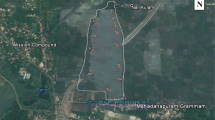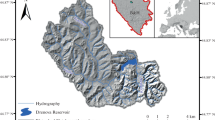Abstract
Shahid Rajaee reservoir (SRR) is one of the main reservoirs located in Mazandaran province. There is no published data of algal study and water quality deduction based on biotic parameter in this area. Therefore, SRR was chosen to study the water quality and water pollution based on the phytoplankton community. Samples were collected at four stations during the 6-month sampling occasions (June, July, August, September, November 2012 and February 2013). Results showed that the water quality of selected sampling stations based on the phytoplankton communities (Shannon-Weiner diversity index H′, 0.92–1.37) were classified as slightly polluted to polluted. The H′ values reflected excellent quality in June (2.80) and February (2.77), whereas the lowest quality was obtained in August (0.58). Based on the saprobic index values, the reservoir was categorized as β-mesosaprobic class (moderate organic loading) except in August which was under α-mesosaprobic to β-mesosaprobic (critical organic loading) classification. The water quality condition derived from the trophic classification (based on chlorophyll-a concentration) varied from good to poor class at different sampling months and stations. Based on the results obtained, the risk of pollution and water quality degradation was more noticeable at station 2 and during July and August 2012. In order to prevent the occurrence of eutrophication and algal bloom, it is necessary to conduct regular monitoring and human activities surrounding the SRR and the river tributaries should be monitored.


Similar content being viewed by others
References
APHA (2005) Standard method for examination of water and wastewater, 18th edn. American public health association publisher, Washington
Barinova SS, Anissimova OV, Nevo E, Jarygin MM, Wasser SP (2004) Diversity and ecology of algae from the Nahal Qishon River, Northern Israel. Plant Biosyst 138:245–259
Carmelo RT (1997) Identifying marine phytoplankton. Publication Harcourt Brace Company, London
Chapman D (1996) Water quality assessments—a guide to use of biota, sediments and water in environmental monitoring, 2nd edition. Great Britain at the University Press, Cambridge. Published on Behalf of the United Nations Educational, Scientific and Cultural Organization World Health Organization, United Nations Environment Programme, Published by E&FN Spon an imprint of Chapman & Hall, UNESCO/WHO/UNE
Chorus I, Bartram J (1999) Toxic cyanobacteria in water, a guide to their public health consequences, monitoring and management. UK, E and FN Son, London
City of Lakeland (2001) Water Quality Report, Florida 1988-2000.USA. http://www.polk.wateratlas.usf.edu/upload/documents/lakeland_lakereport.pdf. Accessed 20 Feb 2005
Coelho S, Gamito S, Perez-Ruzafa A (2006) Trophic state of Foz de Almargem costal lagoon (Algarve, South Portugal) based on the water quality and the phytoplankton community. Estuarine, Coast Shelf Sci 71(1–2):218–231
Dokulil MT (2003) Algae as ecological bioindictators, trace metals and other contaminants in the environment. In: Markert BA, Breure AM, Zechmeister HG (eds) Bioindicators and biomonitors for policy, legislation and administration. Elsevier, Oxford
Ericsson B, Tragardh G (1997) Treatment of surface water rich in humus membrane filtration vs. conventional treatment. Desalination 108(1–3):117–128
Esmaeily Sari A (2000) Fundamental of water quality management in aquaculture. Fishery Research Center of Iran, Tehran (In Persian)
Habit RN, Pankow H (1976) Algenoflora der Ostsee II. Gustav Fischer. Jena University Rostock Publication, Germany
Hellawell JM (1986) Biological indicators of freshwaters pollution and environmental management. Elsevier Applied Science Publishers, London
Ho SC (1994) Status of Limnological research training in Malaysia. International vereinigung fur thepretisch und angewandate limnologie (International Association of Theoretical and Applied Limnology) 24:129–145
Hynes HBN (1966) The biology of polluted waters. Liverpool University Press, UK
Iran Ministry of Energy (2011) Guideline for water quality monitoring of Dams Reservoirs, No. 551, Iran. Bureau of Engineering and Technical Criteria for Water and Wastewater
Khan TA (2003) Limnology of four saline lakes in western Victoria, Australia. II. Biological parameters. Limnologica 33:327–339
Kiss K, Klee R, Ector L, Acs E (2012) Centric diatoms of large rivers and tributaries in Hungary: morphology and biogeographic distribution. Acta Botanica Croatica 71(2):311–363
Krebs CJ (1999) Ecological methodology, 2nd edn. Benjamin/Cumming an imprint of Addison Wesley Longman, England
Makhlough A, Nasrollahzadeh HS, Ramin M, Rezaei M (2016) Study on stracture, abundance and ecology of phytoplankton with emphasis on characteristics of dominant species in Shahid Rajaee Resevoir (Mazandaran). J Plant Res, Accepted paper
Mason CF (1991) Biology of freshwater pollution. Wiley, New York
Mivehchi MR, Ahmadi MT, Hajmomeni A (2003) Effective techniques for arch dam ambient vibration test: application on two Iranian dams. J Sustain Energy Environ 5(2):23–34
Mohebbi F, Mohsenpour Azari A, Asem A (2012) Phytoplankton population and its indices in Aras Dam reservoir. Iran J Biol 25(2):316–328 (in Persian)
Monnavary MS, Noori J, Sohrabnia N (2013) Phytoplankton assembly effect in Karaj reservoir water quality. J Water Wastewater 2:19–30 (in Persian)
Morton S, Vershinin AO, Leighfield T (2008) Identification of yessotoxin in mussels from the Black Sea coast of the Russian Federation. Toxicon 50(4):581–584
Nasrollahzadeh HS, Makhlough A, Vahedi F, Rezaei M (2016) Study on changes of biotic and abiotic parameters, and other biological indices in Shahid Rajaei Reservoir using mono and multivariate statistical analysis. Iran Sci Fish J 24(4):179–194 (in Persian)
Offem BO, Ayotunde EO, Ikpi GU, Ada FB, Ochang SN et al (2011) Plankton-based assessment of the trophic state of three tropical lakes. J Environ Protect 2:304–315
Palmer CM (1980) Algae and water pollution The identification, significance, and control of algae in water supplies and in polluted water. Castle House Publication, London
Pantle R, Buck H (1955) The biological monitoring of water and the presentation of result. Water and Wastewater, Germany
Proshkina-Lavrenko AI, Makarova IV (1968) Plankton algae of the Caspian Sea. Nauka: L. Science, Leningrad (in Russian)
Qaderi A (2002) Analysis of erosion and sediment production in the watershed of Shahid Rajee Dam using remote sensing (RS) and GIS Vmdl MPSIA. J Environ Stud 28(30):9–18 (in Persian)
Reynolds CS, Huszar V, Kruk C, Flores LN, Melo S (2002) Towards a functional classification of the freshwater phytoplankton. J Plankton Res 24(5):417–428
Rott E, Hofmann G, Pall K, Pfister P, Pipp E (1997) Indikationslisten für Aufwuchsalgen in Österreichischen Fliessgewässern. Teil 1: Saprobielle Indikation Wasserwirtschaftskataster. Wien. Bundeministerium f. Land- u. Forstwirtschaft (In German)
Salavatian SM, Abdollapour H, Nezami Baluchie Sh, Makarami M, Pourgolami mogaddam A (2010) Identification and comparison of seasonal phytoplankton density in Lar Dam lake. J Wetland Ecobiol 2(3):26–38 (in Persian)
Shamloo AA, Nasseri S, Naddafi K (2004) Water quality monitoring of the gilarlo reservoir. J Water Wastewater 51:22–27 (in Persian)
Shams M, Afsharzadeh S (2010) Species diversity and ecological studies Euglenophyta in the Zayandeh Rood Lake Dam. J Taxon Biosyst 2(2):1–10
Sigee DC (2005) Freshwater microbiology: biodiversity and dynamic interactionsr of microorganisms in the freshwater Environment. University of Manchester, John Wiley and Sons Inc. USA, UK
Sorokin Y (1999) Aquatic microbial ecology, a textbook for students in environmental sciences. Backhuys Publishers, Leiden
Stein H, Springer M, Kohlmann B (2007) Comparison of two sampling methods for biomonitoring using aquatic macroinvertebrates in the Dos Novillos River, Costa Rica. Ecol Eng 34:267–275
Swaminathan MS (2003) Bio-diversity: an effective safety net against environmental pollution. Environ Pollut 126:287–291
Tiffany H, Britton ME (1971) The algae of Illinois. Hafner Publishing Company, New York
Walley WJ, Grbovic J, Dzeroski SA (2001) Reappraisal of saprobic values and indicator weights based on Slovenian River quality data. Water Res 35:4285–4292
Wan Maznah WO, Makhlough A (2015) Water quality of tropical reservoir based on spatio-temporal variation in phytoplankton composition and physico-chemical analysis. Int J Environ Sci Technol 12(7):2221–2232
Washington HG (1984) Diversity, Biotic and Similarity Indices, A Review with special relevance to Aquatic Ecosystems. Water Res 18:653–694
Water Research Institute. (2000). Sedimentation in the reservoir of large dams. Ministry of Energy, Iran, www.waser.cn/…/Sedimentation%20in%20the%20Reservoir. Accessed 20 Jul 2014
Wehr JD, Sheath RG (2003) Freshwater algae of North America: ecology and classification. Academic Press, New York
Welch EB (1992) Ecological effects of wastewater, applied limnology and pollutant effect, 2nd edn. Chapman and Hall, London
Wetzel RG, Likens GE (2000) Limnological analyses. Springer, New York
Weysi K, Samarghandi MR, Nourmoradi H (2014) Monitoring of the Eutrophication Phenomenon in Ekbatan Reservoir Dam Using Carlson’s index Trophic. Ilam University of Medical Sciences 22, 42–50. (in Persian)
Wu RSS, Siu WHL, Shin PKS (2005) Induction, adaptation and recovery of biological responses: implications for environmental monitoring. Mar Pollut Bull 51:623–634
Yap SY (1997) Classification of a Malaysian river using biological indices: a preliminary attempt. Environ 17(2):79–86
Yeng CK (2006) A study on limnology and phytoplankton biodiversity of Ahning Reservoir, Kedah. (M.Sc. Thesis), Malaysia, University Sains Malaysia
Zarei DB (2011) Algae of aquatic ecosystems of Iran. University of Esfahan, Payam-e Alavi Publication, Iran (in Persian)
Acknowledgment
The authors wish to thank Regional Water Organization of Mazandaran Province (RWOMP) for financial support. The authors also wish to thank the individuals who have contributed in the field and lab plankton works in Caspian Sea Ecology Research Center (CSERC). Finally, we would like to acknowledge the reviewers of the paper for their constructive comments which have helped improve the quality of this manuscript.
Author information
Authors and Affiliations
Corresponding author
Rights and permissions
About this article
Cite this article
Makhlough, A., Saravi, H.N. & Ebrahimzadeh, M. The Water Quality of the Shahid Rajaee Reservoir (Mazandaran-Iran): Based on Phytoplankton Community. Iran J Sci Technol Trans Sci 41, 627–635 (2017). https://doi.org/10.1007/s40995-017-0299-5
Received:
Accepted:
Published:
Issue Date:
DOI: https://doi.org/10.1007/s40995-017-0299-5




